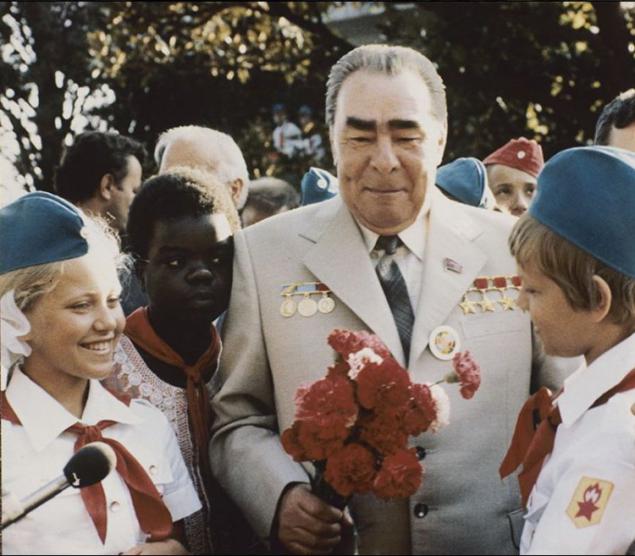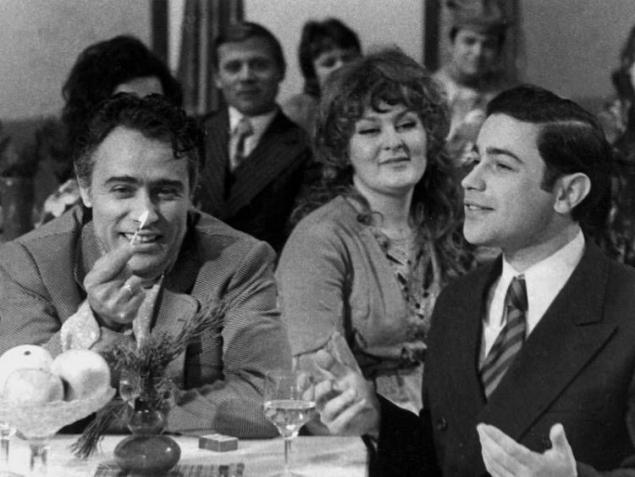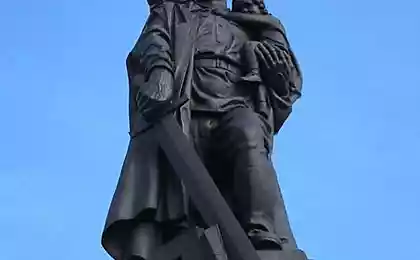1538
The symbols of the Soviet era
Look at the number of symbols of the Soviet era. These are symbols, without which it was impossible to imagine our life when we are all citizens of the Soviet Union. And yet there is in them something unites all.

Volley «Aurora»

Every sailor knows the signs. They knew it, and the sailors "Aurora". The woman on the ship - be trouble. But this woman was so beautiful that the men did not dare to refuse her, could not banish her from the ship. Tall, slender, dressed in a crisp white dress set off the paleness of her stern. "Like a statue come to life," - says the sailors. It was the woman in the evening October 25, 1917 rose to "Aurora", and that it is 21 hours 40 minutes gave the order to produce the blank shot. And the sailors did not dare to disobey it ... The legend lives since as Gunnery Ognev made a weapon of "Aurora" the same shot, became not just a signal to storm the Winter Palace and the starting point of a new era. Age, radically changed the lives of the vast country. Historians who have studied the events of October 1917, claimed that a mysterious stranger could have known revolutionary and writer Larisa Reisner. But people say that beauty - was actually "the spirit of the revolution" and disappeared immediately after the shot.
Artek

"Does everyone: with the letter and the title starts" Artek "- a nice children's camp." So he wrote about the "Artek" Samuil Marshak. But in Soviet times, "Artek" was not just a "nice children's camp" - it was a showcase, which loved to show to foreigners, they say, "See how the rest of our children, look and envy!". Among them were the presidents, prime ministers, kings and queens, astronauts, artists and writers. If any important foreign visitor found himself in the Crimea, it certainly carried in "Artek". "Artek" - a unique phenomenon, a phenomenon which is difficult to explain. Children from all over the Soviet Union and other countries traveled to the Crimea not just relax and get healthier. In the "Artek" I was always present team spirit (not the crowds or the flocks, namely, team builder), any special Artek atmosphere. And employees "Artek" for the short summer children shift became almost family.
Baikal-Amur Mainline

According to the plans, the through traffic on the BAM was opened in 1985. However, construction was completed a year ahead of schedule. September 29, 1984 at the junction Bambuhta in the Chita Region held a "golden docking" - the builders, 10 years marching toward each other from the east and west meet. Like any Soviet "construction of the century", the volume of work performed is amazing. In the construction of the BAM and pritrassovyh road builders moved in ten years more than 600 million cubic meters of soil, threw across rivers and streams around 4,200 bridges and pipes, paved over 5000 kilometers of main and station tracks, built 56 railway stations and 119 trips. The construction of highways attended to half a million people. And as so often, near the grandiose scope and incredible feats of labor coexisted complete poor living conditions of people who commit these deeds. The road was built, the train started up, have reported everything, and the people have forgotten ...
Vladimir Vysotsky

Writing songs Vladimir Semenovich began in the early 60s. At first, it was fashionable in those days, "thieves" romance. Entries Sergey Kuleshov (under the pseudonym while "hiding" Vysotsky) began to disperse in Moscow, but the author himself did not bring creative satisfaction. And only after the song "Submarine" Vysotsky could say to himself: "I - a poet!". "" Submarine "- it was already seriously - recalled one of the closest friends of the poet Igor Kochanowski. - And I think that's what this song is said that it is time his creative youth ended ».
Bolshoi Theatre

"Keep him all sorts of theater performances, as well as concerts, the casino and Masquerades, and besides him, no one, no such amusements were not allowed at all for the privilege of appointed time, that he was not to undermine." March 17, 1776 decree of Her Imperial Majesty Catherine II, the Grand Duke Peter V. Urusov received the exclusive right to the maintenance of Russian theater troupe and the obligation to build in Moscow Bolshoi Petrovsky Street building, which can be played year-round opera, ballet and drama performances. This day is considered the founding date of the Bolshoi Theatre, a unique phenomenon in the history not only of the Russian Empire and the Soviet Union, but the entire world culture. «Bolshoy» - is a Russian translation of the word without understanding any foreigner, who was in Moscow. The character in the history as a mirror which reflects the epoch itself, majestic and tragic at the same time. Prince Urusov zealously took up the matter, but, alas, not yet unfinished theater because of the negligence burned, and have not opened. Cases Peter Urusov, has invested in the theater almost all his fortune, on the verge of collapse, and he gave the privilege of theater to his companion Michael Maddock. The Englishman was more fortunate and brought it started to end. December 30, 1780, the opening day of the theater, then called Peter, it was given a ceremonial presentation of two parts - an allegorical prologue to "The Wanderer" and pantomime ballet "Magic School". Petrovsky Theater troupe consisted of 13 actors, actresses 9, 4 dancers 3 dancers with choreographer and 13 musicians. In those days, the artists had to be, as they say, "mnogostanochnik" - they played in the drama, and opera, and ballet.
Yuri Gagarin

One of the famous announcer Yuri Levitan Radio and Television was asked: "What events in his announcer's job do you remember the most?". "May 9, 1945 - Victory Day and April 12, 1961 - the day of Yuri Gagarin's flight into space - without hesitation said Yuri. - May 9 - it is clear why we have been waiting for the completion of the Great Patriotic War. But human space flight waiting and waiting. We thought that it would be possible within two or three years. And suddenly!..". Or rather because you could not tell. May 45 th and April 61 th ... The two great victories. The victory over the terrible enemy and victory over the force of gravity, hold a person in the world ... Those who had experienced both of these events, recalls that never again in my life experienced such elation. Pride, a sense of something and the overarching supra-- that is the second in April 1961. Pride not only for the country, for the guy with the incredible, magical smile, but also for himself. After all, I live in this country, I have been working for this country, then, in this cosmic breakthrough there, and my contribution, my, albeit microscopically small, but still a personal bit of ... Day April 12, 1961 beginning at 9 hours, 7 minutes Moscow time. No, the usual day started, as expected, at midnight, in 00 hours 00 minutes. But the day of the historic, cosmic day, the day that marked the beginning of a new era in the life of mankind, began in the morning at 9 o'clock in 7 minutes. It was at this time from the cosmodrome "Baikonur" launch vehicle with the spacecraft "Vostok". On board the spacecraft was pilot Yuri Gagarin.
"Seventeen Moments of Spring»

"When Stirlitz goes through the streets of Berlin, the streets of all the cities of the Soviet Union ... are empty." The success of "Seventeen Moments of Spring" was simply stunning. The first series of the movie was shown at half past seven in the evening August 11, 1973. But after three months, as they said in those days, "according to numerous requests of workers" series was shown again. Since then, on different channels, "Seventeen Moments of Spring" showed hundreds if not thousands of times. To say that the film was popular with viewers - to say nothing. The series "Seventeen Moments of Spring" after the first show became a phenomenon of cultural life of the country, and its characters have moved into the category of folk folk characters, Stirlitz stood on a par with Ilya Muromets and Chapaev. What is the secret of the film? In answering this question, Vyacheslav Tikhonov once said: "In the" Seventeen Moments ... "there is a balance between fiction and fact, between harshness and cruelty, have lyrics, but there is no sentiment, no simplifications. In it there is no template indisputable right and wrong actions. There are images and historical truth, "busting" artistic assumptions no ».
Lenin's Mausoleum

January 21, 1924 in 18 hours and 50 minutes, Vladimir Ilyich Lenin died at the dacha outside Moscow in Gorki. The following day, Professor of the Department of Pathological Anatomy of the University of Moscow Alexey Abrikosov made a temporary embalming the body (through the aorta was injected with a mixture of alcohol, formaldehyde and glycerol). "Two months will lie in the crypt?" - Asked Abrikosov the CEC of the USSR. "I think yes. If it is dry and cool. " At the same meeting, he was invited well-known architect Alexey Shchusev, who was entrusted with the construction of a temporary crypt coffin of Lenin. Interestingly, before 1917, Shchusev built churches, with mainly in Ukraine. His first independent work was the draft of the iconostasis of the Assumption Cathedral of the Kiev-Pechersk Lavra. He built a monastery complex projects in Ovruch, Pochayiv Lavra Trinity Cathedral, several other churches. Among the other famous works Shchusev - Kazansky railway station in Moscow, the building of hotel "Moscow", he participated in the drafting of the post-war rehabilitation and reconstruction of Downtown. But the most famous of his work, of course, was the Lenin Mausoleum ...
"Blue light»

April 6, 1962 in the Central Television broadcast a new weekly program. About scenery portraying Shabolovskaya Tower, the tables were set, the atmosphere in the studio resembles the evening cafe. So that the name came by itself - "Television cafes", over time transformed into a "Blue light". Initially, the authors wanted to make a musical program which is based on the performances of various pop genres. From the usual concert "Television Cafe" it is different in that there were major artists who not only broadcast on television, but also they could perform the song. In addition, leading not only declared, "but now speak a certain" but also talked with the artists before their performances. The first issue of "Television cafes" were Mikhail Nozhkin Boris Brunow and Rosa Uruzbaeva.
"Worker and Collective Farm»

In Paris, a brilliant work Mukhina created a furor. The sculpture "Worker and Collective Farm Girl" quite naturally won a gold medal at the Grand Prix. Affects not just the scale (24-meter statue was installed on the roof of the 35-meter pavilion) - evoked the admiration of the audience swiftness of two figures, dynamic way, a clear link with the architecture of the entire statue of the Soviet pavilion. "The perception of this group on the background of the sky in Paris showed how sculpture can be active not only in the overall landscape of the architectural ensemble, but also by its psychological effects - recalls Vera Mukhina. - Higher joy of the artist - to be understood. " The exhibition is over, the fanfare died down, "Worker and Collective Farm" had to go home. Originally we planned to install a sculpture on the Volga River, the dam near Rybinsk. But after the "Worker and Collective Farm" admired in Paris, Rybinsk seemed "unworthy" place for sculpture and decided to install it in Moscow at the All-Union Agricultural Exhibition (VSHV). Vera Mukhina sharply opposed this, believing that the pedestal, which is three times lower than the exhibition hall, art destroys the perception of sculptural groups: "The figures are crawling rather than flying." The author wanted to see his creation on the Sparrow Hills, where it is, in her opinion, would look in an advantageous light.

Volley «Aurora»

Every sailor knows the signs. They knew it, and the sailors "Aurora". The woman on the ship - be trouble. But this woman was so beautiful that the men did not dare to refuse her, could not banish her from the ship. Tall, slender, dressed in a crisp white dress set off the paleness of her stern. "Like a statue come to life," - says the sailors. It was the woman in the evening October 25, 1917 rose to "Aurora", and that it is 21 hours 40 minutes gave the order to produce the blank shot. And the sailors did not dare to disobey it ... The legend lives since as Gunnery Ognev made a weapon of "Aurora" the same shot, became not just a signal to storm the Winter Palace and the starting point of a new era. Age, radically changed the lives of the vast country. Historians who have studied the events of October 1917, claimed that a mysterious stranger could have known revolutionary and writer Larisa Reisner. But people say that beauty - was actually "the spirit of the revolution" and disappeared immediately after the shot.
Artek

"Does everyone: with the letter and the title starts" Artek "- a nice children's camp." So he wrote about the "Artek" Samuil Marshak. But in Soviet times, "Artek" was not just a "nice children's camp" - it was a showcase, which loved to show to foreigners, they say, "See how the rest of our children, look and envy!". Among them were the presidents, prime ministers, kings and queens, astronauts, artists and writers. If any important foreign visitor found himself in the Crimea, it certainly carried in "Artek". "Artek" - a unique phenomenon, a phenomenon which is difficult to explain. Children from all over the Soviet Union and other countries traveled to the Crimea not just relax and get healthier. In the "Artek" I was always present team spirit (not the crowds or the flocks, namely, team builder), any special Artek atmosphere. And employees "Artek" for the short summer children shift became almost family.
Baikal-Amur Mainline

According to the plans, the through traffic on the BAM was opened in 1985. However, construction was completed a year ahead of schedule. September 29, 1984 at the junction Bambuhta in the Chita Region held a "golden docking" - the builders, 10 years marching toward each other from the east and west meet. Like any Soviet "construction of the century", the volume of work performed is amazing. In the construction of the BAM and pritrassovyh road builders moved in ten years more than 600 million cubic meters of soil, threw across rivers and streams around 4,200 bridges and pipes, paved over 5000 kilometers of main and station tracks, built 56 railway stations and 119 trips. The construction of highways attended to half a million people. And as so often, near the grandiose scope and incredible feats of labor coexisted complete poor living conditions of people who commit these deeds. The road was built, the train started up, have reported everything, and the people have forgotten ...
Vladimir Vysotsky

Writing songs Vladimir Semenovich began in the early 60s. At first, it was fashionable in those days, "thieves" romance. Entries Sergey Kuleshov (under the pseudonym while "hiding" Vysotsky) began to disperse in Moscow, but the author himself did not bring creative satisfaction. And only after the song "Submarine" Vysotsky could say to himself: "I - a poet!". "" Submarine "- it was already seriously - recalled one of the closest friends of the poet Igor Kochanowski. - And I think that's what this song is said that it is time his creative youth ended ».
Bolshoi Theatre

"Keep him all sorts of theater performances, as well as concerts, the casino and Masquerades, and besides him, no one, no such amusements were not allowed at all for the privilege of appointed time, that he was not to undermine." March 17, 1776 decree of Her Imperial Majesty Catherine II, the Grand Duke Peter V. Urusov received the exclusive right to the maintenance of Russian theater troupe and the obligation to build in Moscow Bolshoi Petrovsky Street building, which can be played year-round opera, ballet and drama performances. This day is considered the founding date of the Bolshoi Theatre, a unique phenomenon in the history not only of the Russian Empire and the Soviet Union, but the entire world culture. «Bolshoy» - is a Russian translation of the word without understanding any foreigner, who was in Moscow. The character in the history as a mirror which reflects the epoch itself, majestic and tragic at the same time. Prince Urusov zealously took up the matter, but, alas, not yet unfinished theater because of the negligence burned, and have not opened. Cases Peter Urusov, has invested in the theater almost all his fortune, on the verge of collapse, and he gave the privilege of theater to his companion Michael Maddock. The Englishman was more fortunate and brought it started to end. December 30, 1780, the opening day of the theater, then called Peter, it was given a ceremonial presentation of two parts - an allegorical prologue to "The Wanderer" and pantomime ballet "Magic School". Petrovsky Theater troupe consisted of 13 actors, actresses 9, 4 dancers 3 dancers with choreographer and 13 musicians. In those days, the artists had to be, as they say, "mnogostanochnik" - they played in the drama, and opera, and ballet.
Yuri Gagarin

One of the famous announcer Yuri Levitan Radio and Television was asked: "What events in his announcer's job do you remember the most?". "May 9, 1945 - Victory Day and April 12, 1961 - the day of Yuri Gagarin's flight into space - without hesitation said Yuri. - May 9 - it is clear why we have been waiting for the completion of the Great Patriotic War. But human space flight waiting and waiting. We thought that it would be possible within two or three years. And suddenly!..". Or rather because you could not tell. May 45 th and April 61 th ... The two great victories. The victory over the terrible enemy and victory over the force of gravity, hold a person in the world ... Those who had experienced both of these events, recalls that never again in my life experienced such elation. Pride, a sense of something and the overarching supra-- that is the second in April 1961. Pride not only for the country, for the guy with the incredible, magical smile, but also for himself. After all, I live in this country, I have been working for this country, then, in this cosmic breakthrough there, and my contribution, my, albeit microscopically small, but still a personal bit of ... Day April 12, 1961 beginning at 9 hours, 7 minutes Moscow time. No, the usual day started, as expected, at midnight, in 00 hours 00 minutes. But the day of the historic, cosmic day, the day that marked the beginning of a new era in the life of mankind, began in the morning at 9 o'clock in 7 minutes. It was at this time from the cosmodrome "Baikonur" launch vehicle with the spacecraft "Vostok". On board the spacecraft was pilot Yuri Gagarin.
"Seventeen Moments of Spring»

"When Stirlitz goes through the streets of Berlin, the streets of all the cities of the Soviet Union ... are empty." The success of "Seventeen Moments of Spring" was simply stunning. The first series of the movie was shown at half past seven in the evening August 11, 1973. But after three months, as they said in those days, "according to numerous requests of workers" series was shown again. Since then, on different channels, "Seventeen Moments of Spring" showed hundreds if not thousands of times. To say that the film was popular with viewers - to say nothing. The series "Seventeen Moments of Spring" after the first show became a phenomenon of cultural life of the country, and its characters have moved into the category of folk folk characters, Stirlitz stood on a par with Ilya Muromets and Chapaev. What is the secret of the film? In answering this question, Vyacheslav Tikhonov once said: "In the" Seventeen Moments ... "there is a balance between fiction and fact, between harshness and cruelty, have lyrics, but there is no sentiment, no simplifications. In it there is no template indisputable right and wrong actions. There are images and historical truth, "busting" artistic assumptions no ».
Lenin's Mausoleum

January 21, 1924 in 18 hours and 50 minutes, Vladimir Ilyich Lenin died at the dacha outside Moscow in Gorki. The following day, Professor of the Department of Pathological Anatomy of the University of Moscow Alexey Abrikosov made a temporary embalming the body (through the aorta was injected with a mixture of alcohol, formaldehyde and glycerol). "Two months will lie in the crypt?" - Asked Abrikosov the CEC of the USSR. "I think yes. If it is dry and cool. " At the same meeting, he was invited well-known architect Alexey Shchusev, who was entrusted with the construction of a temporary crypt coffin of Lenin. Interestingly, before 1917, Shchusev built churches, with mainly in Ukraine. His first independent work was the draft of the iconostasis of the Assumption Cathedral of the Kiev-Pechersk Lavra. He built a monastery complex projects in Ovruch, Pochayiv Lavra Trinity Cathedral, several other churches. Among the other famous works Shchusev - Kazansky railway station in Moscow, the building of hotel "Moscow", he participated in the drafting of the post-war rehabilitation and reconstruction of Downtown. But the most famous of his work, of course, was the Lenin Mausoleum ...
"Blue light»

April 6, 1962 in the Central Television broadcast a new weekly program. About scenery portraying Shabolovskaya Tower, the tables were set, the atmosphere in the studio resembles the evening cafe. So that the name came by itself - "Television cafes", over time transformed into a "Blue light". Initially, the authors wanted to make a musical program which is based on the performances of various pop genres. From the usual concert "Television Cafe" it is different in that there were major artists who not only broadcast on television, but also they could perform the song. In addition, leading not only declared, "but now speak a certain" but also talked with the artists before their performances. The first issue of "Television cafes" were Mikhail Nozhkin Boris Brunow and Rosa Uruzbaeva.
"Worker and Collective Farm»

In Paris, a brilliant work Mukhina created a furor. The sculpture "Worker and Collective Farm Girl" quite naturally won a gold medal at the Grand Prix. Affects not just the scale (24-meter statue was installed on the roof of the 35-meter pavilion) - evoked the admiration of the audience swiftness of two figures, dynamic way, a clear link with the architecture of the entire statue of the Soviet pavilion. "The perception of this group on the background of the sky in Paris showed how sculpture can be active not only in the overall landscape of the architectural ensemble, but also by its psychological effects - recalls Vera Mukhina. - Higher joy of the artist - to be understood. " The exhibition is over, the fanfare died down, "Worker and Collective Farm" had to go home. Originally we planned to install a sculpture on the Volga River, the dam near Rybinsk. But after the "Worker and Collective Farm" admired in Paris, Rybinsk seemed "unworthy" place for sculpture and decided to install it in Moscow at the All-Union Agricultural Exhibition (VSHV). Vera Mukhina sharply opposed this, believing that the pedestal, which is three times lower than the exhibition hall, art destroys the perception of sculptural groups: "The figures are crawling rather than flying." The author wanted to see his creation on the Sparrow Hills, where it is, in her opinion, would look in an advantageous light.























